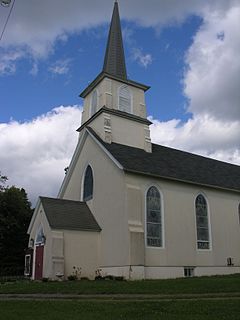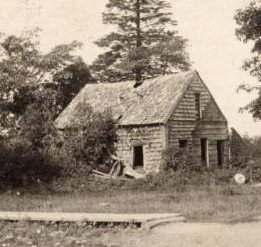
A log cabin is a small log house, especially a less finished or less architecturally sophisticated structure. Log cabins have an ancient history in Europe, and in America are often associated with first generation home building by settlers.

The Thomas D. Campbell House is a historic Gothic Revival style log and wood frame home located in Grand Forks, North Dakota. It is significant for its association with Thomas D. Campbell, who became the largest wheat farmer in the United States. It is part of the Myra Museum and is listed on the National Register of Historic Places.

The Gustaf Adolph Lutheran Church is a historic church at 29 Capitol Hill Road in New Sweden, Maine. The congregation was established by Swedish immigrants to the area in 1871, and the Gothic Revival sanctuary was built in 1879-80. In 1896 the church was named in honor of King Gustavus Adolphus of Sweden. It was listed on the National Register of Historic Places in 1997. The church congregation was in 2003 subjected to one of the nation's largest cases of arsenic poisoning, apparently perpetrated by one of its parishioners.

Watson Settlement Bridge was an historic covered bridge in eastern Littleton, Maine, United States. Built in 1911, it was one of the youngest of Maine's few surviving covered bridges. It formerly carried Framingham Road over the Meduxnekeag River, but was closed to traffic, the road passing over a modern bridge to its south. It was listed on the National Register of Historic Places in 1970. It was destroyed by fire on July 19, 2021.
The Benjamin C. Wilder House is an historic house at 1267 Main Street in Washburn, Maine. Built about 1852, it is a well-preserved example of mid-19th century vernacular architecture in northern Aroostook County, built in the first decade after widespread settlement began of the area. The house was listed on the National Register of Historic Places in 1987. It is now owned by the local Salmon Brook Historical Society and operated as a historic house museum.
The Nicholas P. Clase House is a historic house on the south side of Station Road, west of its junction with Capitol Hill Road, in New Sweden, Maine. It is a log structure, built in 1874 by a Swedish immigrant to the area, and is one of a small number of surviving log structures in Maine built using Swedish techniques. It was listed on the National Register of Historic Places in 1989, at which time it was still in the hands of Clase's descendants.
The Jean-Baptiste Daigle House is a historic house at 4 Dubé Street in Fort Kent, Maine. Built c. 1840, it is a rare surviving example of an Acadian log house, and the only one known to be near its original location. It was built by one of a father-son pair, each named Jean-Baptiste Daigle, and moved a short distance about 20 years after its construction. It is now covered by weatherboard siding, obscuring its log structure. The house was listed on the National Register of Historic Places in 2013.
The Donovan–Hussey Farms Historic District encompasses a pair of 19th-century farm properties in rural Houlton, Maine. Both farms, whose complexes stand roughy opposite each other on Ludlow Road northwest of the town center, were established in the mid-19th century, and substantially modernized in the early 20th century. As examples of the changing agricultural trends of Aroostook County, they were listed on the National Register of Historic Places in 2009.

The Governor Brann School is a historic school building on United States Route 1 in Cyr Plantation, Maine. It presently is used by the plantation as a polling station and meeting place. The school was named for Louis J. Brann, who was Governor of Maine at the time of its construction in 1934. It is the best-preserved of the community's former district school buildings; it was listed on the National Register of Historic Places in 1993.
The Pehr J. Jacobson House is a historic log house at 452 New Sweden Road in New Sweden, Maine. It was built c. 1870 by one of the first Swedish immigrants drawn to the area as part of a state program. It is one of a small number of surviving log houses in the state built by Swedish immigrants, and reflects their distinctive construction style. The house was listed on the National Register of Historic Places in 2007.
The Larsson–Noak Historic District encompasses a collection of buildings constructed by Swedish immigrants to northern Maine between about 1888 and 1930. The district is focused on a cluster of four buildings on Station Road, northeast of the center of New Sweden, Maine. Notable among these is the c. 1888 Larsson-Ostlund House, which is the only known two-story log house built using Swedish construction techniques in the state. Across the street is the c. 1900 Noak Blacksmith Shop, a virtually unaltered building housing original equipment. The district was listed on the National Register of Historic Places in 1989.
The Anders and Johanna Olsson Farm is a historic farmstead at 354 West Road in New Sweden, Maine, United States. It includes surviving elements of both a log house and log barn built in the late 19th century by Anders Olsson, a Swedish immigrant. The barn is the only known surviving barn in Maine to have been built during the wave of Swedish immigration in the later decades of the 19th century. The property was listed on the National Register of Historic Places in 1996.
St. John Catholic Church is a historic church building on St. John Street in St. John Plantation, Maine. Built between 1909 and 1911, it is a finely-detailed and handsome example of religious Colonial Revival architecture in a remote rural setting. The building was listed on the National Register of Historic Places in 2003.

The William Sewall House is a historic house at 1027 Crystal Road in Island Falls, Maine. Built in 1865, it is a well-preserved example of vernacular Greek Revival style in a rural setting. The house is notable as the longtime home of a second-generation resident of the community, William Wingate Sewall, who had a long and enduring friendship with Theodore Roosevelt, a regular guest until 1878. The house was listed on the National Register of Historic Places in 1982. It is still in the hands of Sewall descendants, operated as a yoga retreat center.
The John J. and Martha Sodergren Homestead is a historic late 19th-century farmstead in Maine State Route 161 in Stockholm, Maine. The central feature of the nearly 80-acre (32 ha) property is a modest house, built out of logs by Swedish immigrants. The property, one of the few remaining log structures built by Swedish immigrants in the state, was listed on the National Register of Historic Places in 2007
Sunset Lodge is a historic summer lodge on the shore of Madawaska Lake in rural northern Aroostook County, Maine. It is a peeled log structure, built in 1932 by Bruce Ward, founder of Ward Cedar Log Homes, and early marketer of log structures for recreational and year-round living. The building was listed on the National Register of Historic Places in 1994.

The William Dillard Homestead is a historic homestead property in rural northeastern Stone County, Arkansas. It is located on the Round Bottom area northeast of Mountain View, on a plateau above the river's flood plain. It consists of two log structures, both now used as barns, that were built c. 1837, and are the oldest standing structures in the county. A single-pen log cabin stands on rough stone piers, and is covered by a gable roof. The walls are rough-hewn logs, joined by V notches. A shed-roof ell extends on the southern side of the structure, and more modern box-constructed sheds are attached to the north and east sides. A double crib barn stands across the road from the cabin.
The Sam Marshall House is a historic house in rural Searcy County, Arkansas. It is located southeast of Morning Star, on the west side of County Road 163. It is a single-story log structure, rectangular in plan, with a roof whose front gable extends over a porch supported by square columns. The logs were apparently hand-hewn, and joined by dovetailed notches. Built in 1929, it is one of the latest examples of log construction in the county.
The Joe Emmer House was a historic house in rural northern White County, Arkansas. It was located on County Road 47, northwest of the Holly Springs Church. It was a single-story single-pen log structure, with a side gable roof and a shed-roof porch across the front. The logs were hand-hewn and joined by dovetailed notches. A frame addition extended the building to the west. The house was built c. 1890, and was one of about thirty such houses remaining in the county.
The Herman Ojala Homestead, in Valley County, Idaho, near Lake Fork, Idaho, was built around 1902. It was listed on the National Register of Historic Places in 1982.








